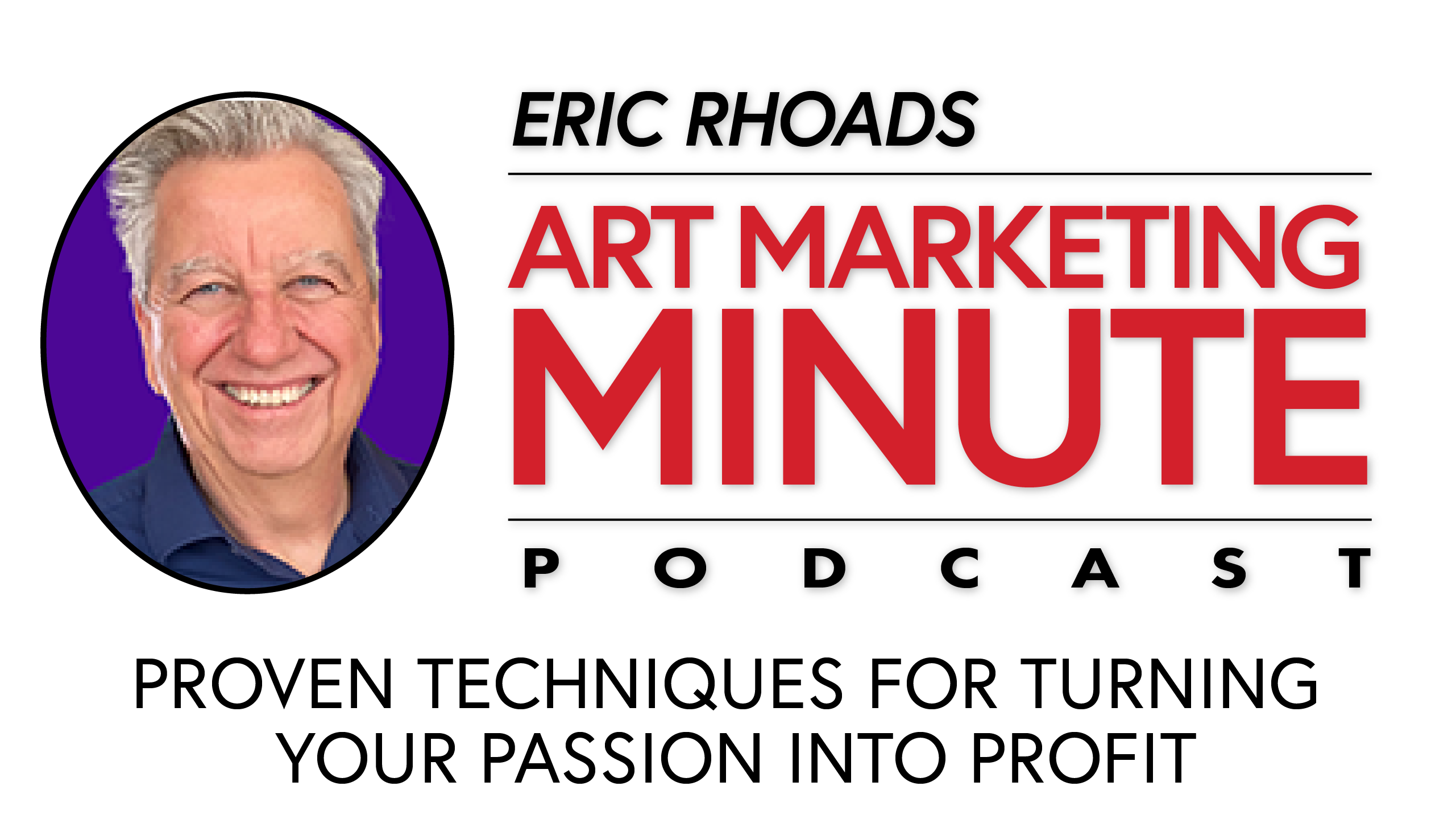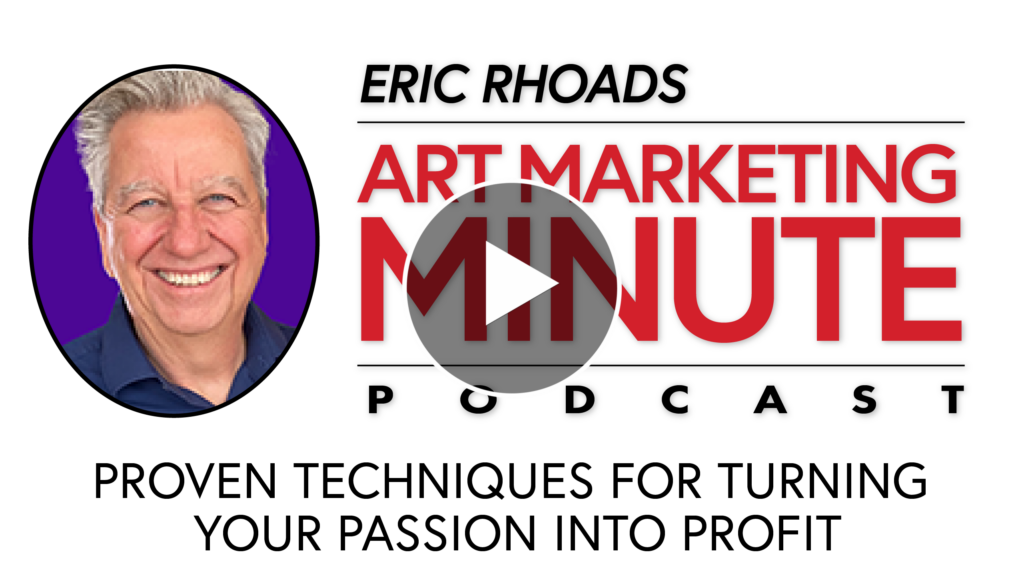How do you craft a compelling artist statement? Is it smart to make prints of your paintings, and if so, how and where should you sell them? Eric Rhoads answers in this week’s Art Marketing Minute Podcast.
Get your copy of Eric’s #1 Amazon Best Seller, “Make More Money Selling Your Art: Proven Techniques for Turning Your Passion Into Profit” here.
Listen to the Art Marketing Minute Podcast: Episode 139 >
Submit Your Art Marketing Question:
What questions do you have about selling your art? Visit artmarketing.com/questions or e-mail Eric at [email protected] (include your name and where you’re from) to hear your question answered on an upcoming Art Marketing Minute Podcast.
FULL TRANSCRIPT of the Art Marketing Minute:
DISCLAIMER: The following is the output of a transcription from an audio recording of the Art Marketing Minute. Although the transcription is mostly correct, it is sometimes slightly inaccurate due to the recording and/or software transcription.
Announcer:
This is the Art Marketing Minute with Eric Rhoads, author of the Amazon best-selling book, “Make More Money Selling Your Art.” In the marketing minute, we answer your questions to help your art career brought to you by ArtMarketing.com, the place to go to learn more about marketing. Now, here’s your host, art magazine publisher, Eric Rhoads.
Eric Rhoads:
Send me your questions at [email protected] or you can go live if you want to, just let us know if you’d like to do that, and we’ll let you do it. The first question comes from Neil Patrick McMillan. Question is, how can artists craft a compelling artist statement and build a strong brand that reflects their unique perspective and artistic identity? Wow, that’s a tough question. You know, I’ve never really completely understood this artist statement thing. I hear a lot of artists ask me, what should my artist statement be? I don’t know where that’s coming from. I don’t know if galleries are asking for it, or if you think it’s something you need to have on your website, you know, I suppose. And I’ve seen artists statements on websites and it’s like, Oh, why? Why bother? You know, it’s, it’s, you know, does anybody really care? Sorry, I know you do. But, you know, do consumers really care? I think the question is, why do you do it? Why? What’s the purpose of doing it? And I would say, if you’re going to do it, then make it, you know, I’ve seen some that have a lot of platitudes in them, and they’re just kind of overly flowerly Look. Just talk, talk about what you do and why you do it. What, what is it that makes you unique and why you do it? Right? Because that’s that’s differentiation, right? So Neil Patrick McMillan, I don’t know what you paint, but let’s say you say, Hey, I’m a realist painter in the tradition of the 19th century, painters focus on making paintings that kind of harken back to those days, and I fell in love with the great masters, and so I want to interpret their style, but I want to do it in my modern way. I mean, that’s really what and I, by the way, I wouldn’t create a special page to say that I’d have that right there at the top of your website that says, This is what I do, because you want people to be able to assimilate very quickly, you know what? What is this website? What am I going to see here and make sure? Of course, everything kind of falls into that. Now also, you’re, you’re talking about branding, and I don’t know, you know slogans. I love slogans, but slogans don’t always work in branding, and sometimes, especially for artists, the slogan you know, Thomas Kincaid did painter of light that worked. And you know, you see people doing that kind of thing, painter of this, painter that you know, but I don’t know if that’s really all that necessary. Your brand is you. You are your brand, and your brand is your attitude, your life, your lifestyle, and you know what you’re posting on social media about your life, and you know if you’re trying to, if you’re doing a lot of plein air painting, and it’s a romantic life, and and you’re you’re out painting the world, then that becomes part of your brand. But really, your brand is your paintings, right? Your your paintings need to be consistent. They need to reinforce what you do, what you believe in. If it’s a style, you know, you’re the, you’re a modern impressionist, or you know you’re a, you know, hearkening to the past, you know, the, you know, Rembrandt style or something, whatever it is, reinforce that, you know, having a slogan, like Have it your way, like McDonald’s or something, isn’t necessarily going to do it. What does do it is reinforcing your work. Just, and branding is, I mean, we talk about branding all the time, and it’s branding is just, it’s who you are, right? And you’ve got to be who you are. You can’t make up some who you’re not. I mean, people are going to know. I mean, I would think so anyway. So just be who you are and just reinforce that. And you just have to be constantly talking about it, constantly telling your story, constantly letting people see your work, constantly promoting yourself, advertising, looking for ways to get visibility. I mean, that’s what branding is really all about. It’s it’s taking your message and exposing it over and over and over and over and again for the rest of your life, right? It never stops.
Next question from Janet Hall. I don’t know where Janet’s from, but let’s see what the question is says. I’m not even sure how or where to make. Prints in my art, which paper to use? How do I do that, let alone marketing? So I get so overwhelmed because I have so many questions I don’t even know where to begin, because I don’t know what. I don’t know, if you get my drift, thanks for letting me ask questions that are probably obvious to everyone else. Well, Janet, I you know, I you know, I don’t want to disappoint you, but I can’t answer questions about that because I don’t know the answers. I don’t know how to tell you where to get your prints made. I know what a lot of people do. I know what a lot of artists will go out and they’ll buy a good, a good printer, and Epson printer or Canon printer, and they’ll, you know, depending on the size prints they want, those are the two standards. And then you buy your you buy different kinds of paper. You can buy watercolor paper or print paper or photographic paper. You know, there’s a lot of different options. And then, you know, you mount them and do all that stuff. And you can find somebody who can teach you that I’m not probably best to do it. The question I would have is, is that what you want to do is, prints are, is marketing prints? What you want to do and and if so, real question is, if you have them, how are you going to sell them? Where are you going to expose them? Where are you going to put them? You going to do tent shows where you’re, you know, art shows where you’re, you know, everybody’s got a tent, and people are walking up down the street. Are you going to put them on a website? Are you going to put them in a gallery? You know, all those things matter, so you need to figure that out first, because that’s probably more important, because you can make the prints once you figure out how you’re going to sell them. And I would test it, because you don’t want to go out and buy a bunch of expensive stuff and spend a lot of money making prints if they don’t sell. So you got to figure out how to do that. I would say, though, really what I think you’re asking is, where do I begin? Right? Some basics. First off, when you’re first starting out, you know, you don’t know what to do. Read some books. There’s lots of great books on art business and art marketing. I wrote one. I don’t know if it’s great or not, but I tried to make it great anyway. Dip your toe in the water, right? And what I mean by that is, find out first, if you’re ready, get some feedback from somebody who knows, somebody who’s a professional, might be some other artists might be some gallery people try to get them to give you some feedback. Am I ready? What do I need to fix? Don’t tell me all the positives, just tell me all the negatives. What do I need to fix? And if you’re ready, they’ll tell you. You know, I I had a lot of years where I wasn’t ready, and I thought I was ready, and all my friends told me about it was ready, but the pros didn’t, you know. Now the pros say, Hey, you’re ready. Okay, so now I’m ready. Now, then the next question is, how are you going to get yourself out there? What are you going to do? How you put yourself out there? Well, I would say, dip your toe in the water of selling something, right? And so what does that look like? Well, it might be doing an art show. It might be putting your stuff up at a restaurant or local gym, or, you know, I like restaurants because there’s alcohol involved, and people get a little bit looser and and a little bit more open to art than they might be when they’re in a busy, you know, work mode, or workout mode or something like that, you know. So find somebody to do a show, and then, you know, sit through there and see what it’s like and and see if you like it. See if that’s the way you want to sell. Maybe you’re going to find a gallery or something, you know, when you’re first starting out less likely, but it depends on how good you are. And you’re of course, going to have to talk to some galleries to talk to them into it and and I’ve got a whole chapter on that my book. But most important is, don’t spend a lot of money yet, till you you get a feel for things. Test everything. Try everything. You know one answer does not apply to all you just got to see what works, and trying to sell some artwork and see if you get some response is a really good way to go. Anyway. I hope this helps. These are quick, but that’s why it’s the art marketing minute.
How to Submit Your Art Marketing Questions: What questions do you have about selling your art? Submit it at artmarketing.com/questions to hear your question answered on an upcoming Art Marketing Minute Podcast.
The Art Marketing Minute Podcast has been named one of the 2023 “Top 25 Art Business and Marketing Blogs on the web” by FeedSpot.



Leave A Comment